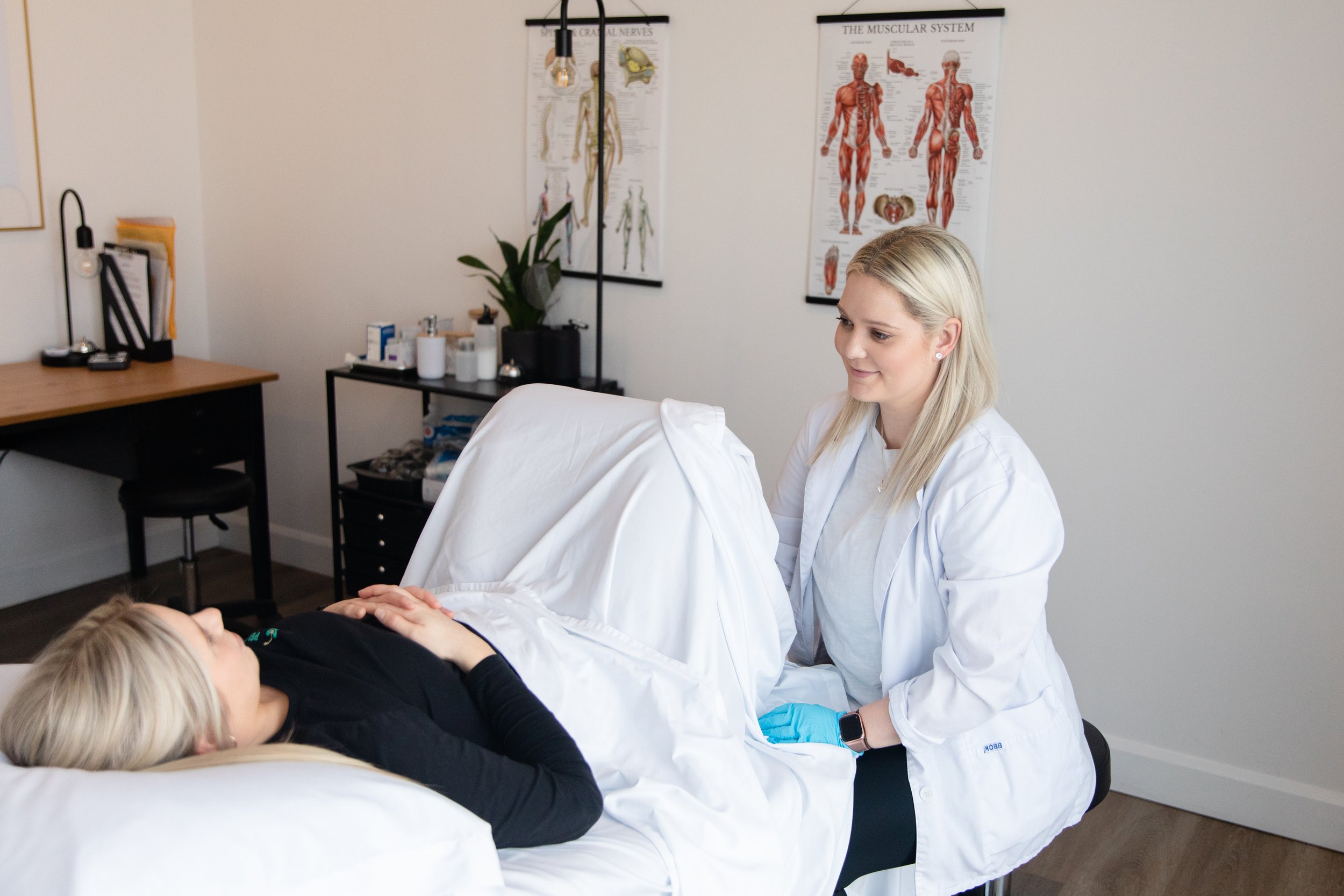
Physiotherapy for everyone
We provide clients with pelvic floor physiotherapy and orthopedic physiotherapy.

If you are living with any of the following, keep reading to learn how pelvic floor physiotherapy can help you.
Pelvic floor dysfunction
Diastasis recti
Cesarean section (‘c-section’) recovery, scar mobilization/pain and rehabilitation
Perineal trauma such as episiotomies, or trauma associated with birth or accidents
Urinary and Fecal Incontinence or urgency/frequency associated with the bowel and bladder
Pelvic Organ Prolapse or pressure/heaviness in and around the pelvis
Pelvic pain such as Vulvoydnia, Vaginismus, pain associated with interstitial cystitis/bladder pain/ endometriosis/ coccydynia (tailbone pain), pudendal neuralgia and more
Chronic hip or low back pain, not resolving with traditional therapy
Pain with penetration/sexual dysfunction
Male pelvic pain: non bacterial prostatitis, musculoskeletal related pelvic pain (testicular pain, rectal pain)
Athletic dysfunction associated with the pelvis
Pelvic Floor Physiotherapy
Pelvic floor physiotherapy focuses on the assessment and treatment of the bones, joints, muscles and nerves of the pelvic floor. While treatment often targets the pelvic muscles all structures of the pelvis are assessed. Just like anywhere else in the body, pelvic muscles can become injured or have dysfunction. We offer pelvic floor physiotherapy for all genders. Our physiotherapists are committed to offering you treatment in a welcoming, non-judgemental and inclusive environment. See FAQ’s below for more information on common conditions we treat.
Orthopedic Physiotherapy
Orthopedic physiotherapy is the most commonly understood treatment approach. Sometimes thought of as “general” physiotherapy, this type of treatment rehabilitates bone, joints and muscles.
Orthopedic treatment is offered to all genders, ages, conditions and abilities through active and passive approaches that will help reduce your pain and/or improve your mobility.
For the Athlete
Our experienced physiotherapists are positioned to cater to athletes, weekend warriors and fitness enthusiasts alike. We offer personalized injury rehab and sport-specific care to unlock your athletic potential, recover from injury, prevent injuries and enhance performance.
Dry Needling
Dry needling is a quick and effective technique used for pain relief and muscle recovery. Dry needling uses fine, sterile needles to release muscle tension and promote tissue healing. Whether you’re looking for pain relief from chronic pain, muscle stiffness or sports injuries, our skilled clinicians will provide personalized care to help you achieve your goals.
Frequently Asked Questions (FAQs)
-
Pelvic floor dysfunction
Diastasis recti
Cesarean section (‘c-section’) recovery, scar mobilization/pain and rehabilitation
Perineal trauma such as episiotomies, or trauma associated with birth or accidents
Urinary and Fecal Incontinence or urgency/frequency associated with the bowel and bladder
Pelvic Organ Prolapse or pressure/heaviness in and around the pelvis
Pelvic pain such as Vulvoydnia, Vaginismus, pain associated with interstitial cystitis/bladder pain/endometriosis/coccydynia (tailbone pain), pudendal neuralgia and more
Chronic hip or low back pain, not resolving with traditional therapy
Pain with penetration/sexual dysfunction
Male pelvic pain: non bacterial prostatitis, musculoskeletal related pelvic pain (testicular pain, rectal pain)
Athletic dysfunction associated with the pelvis
-
Similar to if you were to hurt your knee, physiotherapists will help to assess, diagnose and treat your issues.
Physiotherapists use hands-on techniques to help stretch, release and strengthen the muscles of your pelvic floor.
Specialized technology like muscle stimulation can help muscles regain proper function.
We also focus on core, functional exercises and breathing to assist with treating your pelvic floor.
-
The pelvic floor is a group of muscles located in the pelvis that span from the pubic bone in the front to the tailbone in the back. They are responsible for many things, including:
Support: these muscles support our internal organs against gravity and pressures that occur in the abdomen and vaginal and rectal walls.
Sphincteric control: these muscles control the opening and closing of the urethra, vagina and rectum so we can go to the toilet when we actually want to!
Sexual function: these muscles provide tone for the vaginal and rectal canal to allow for blood flow and penetration.
Stability: assist in the stability of the sacroiliac joints, pubic symphysis, sacrococcygeal, lumbo-pelvic and hip joints and assist in unloading the spine.
-
Canadian physiotherapists who are trained to assess and treat the pelvic floor have advanced training to perform internal exams. But why is an internal exam necessary?
A digital internal vaginal/rectal exam is the gold standard of care to ensure we have a comprehensive understanding of why you are experiencing pelvic issues.
Your physiotherapist will walk you through every step of the process and check in during the exams to make sure you are comfortable.
Treatment is done in private rooms without the use of a speculum. The physiotherapist will gently and respectfully use their hands to perform the exam. During the exam, we will ensure that you are informed about what is happening and why and to ensure you are as comfortable as possible.
Before your internal exam:
We will talk with you about the history of your symptoms. We will help you understand the anatomy and role of your pelvic floor and explain what we look for during the exam.
We will discuss the risks and benefits of treatment.
We will do an external exam.
We will answer any and all of your questions.
If, for any reason, you would like to stop, you can stop. You are in control of your appointment and exam. You are the one in control at all times.
If you choose not to complete an internal exam, that is your choice. There are other methods of assessing the pelvic floor. Although those methods are not as accurate.
Every treatment option is agreed on by both the physiotherapist and, most importantly, you. You are welcome to bring a support person to your appointment.
We have gone through all of these exams ourselves, so we know how it feels. We want you to feel safe and at ease.
-
No. We strongly encourage an internal exam because it is the gold standard or care.
Our hands give us the most accurate information. If you still choose not to complete an internal exam, we have other options, such as external techniques, to guide you as best as we can.
-
Injury or dysfunction to the pelvic floor can occur in various ways.
Often during and after pregnancy, changes to our bodies, as well as changes in hormones, can contribute to changes in the pelvic floor. Labour and delivery also play a role in injury to our pelvic floors. Not only can vaginal deliveries cause injury, but cesarean sections also contribute to dysfunction in the pelvis.
Pelvic floor dysfunction can also occur as a result of menopause, surgery, falls, infections, exercise, and sports stress.
Pelvic floor injuries and dysfunctions can lead to incontinence (leaking urine), pelvic organ prolapse, pain with intercourse, pelvic pain or testicular pain.
We also know there is a relationship between pelvic floor dysfunction and low back and hip pain.
-
In Canada, physiotherapists are primary health care practitioners. This means you do not need a referral.
Some insurance companies do require a referral to complete billing, but ultimately, you can refer yourself.
-
Absolutely. It can actually be helpful to see a patient during menstruation as it will give us an idea of what the tone of the pelvic floor is like.
Changes in hormones during your cycle can change the tone of your pelvic floor.
-
Absolutely. Men have pelvises too and we won’t leave them out.
Many men experience pelvic pain and incontinence. A particular population we see often is men who have had prostatectomies and are looking to recover and rehab after the surgery.
-
Yes! We love seeing patients during pregnancy for many reasons.
We can help you with pelvic pain or low back pain, which can be relieved by physiotherapy.
Meeting with you during pregnancy gives us an idea of the integrity of the pelvic floor before you give birth. This is important because postpartum, we can compare how the muscles are reacting and help you with dysfunctions that occurred during birth.
We can help you get back into exercise or continue exercising during your pregnancy and help you modify or change activities to reach your fitness goals.
If you have been told to refrain from intercourse by your doctor, please let us know, as an internal exam will not be performed. However, this doesn’t mean you shouldn’t come. We have lots of external techniques to help you with your pain and dysfunctions.
-
Your initial assessment will run anywhere from an hour to an hour and a half in duration. Follow-up appointments will be approximately 30 minutes to an hour.
-
Many people have been told to do kegels, but the reality is that many shouldn’t.
If you have too much tone or your muscles are too tight, this can cause many problems and contribute to issues such as urinary incontinence.
We will also ensure you know the proper way to do kegels.
-
You are always entitled to have a third party of your choice at your appointment. We always welcome you to bring a cheering squad!




